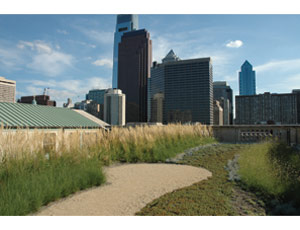Philadelphia has launched an ambitious 20-year, $1.6-billion stormwater control plan that its creators hope will transform the city’s combined-sewer system and its urban landscape with new shades of green, including bio-mimetic systems.


America’s sixth-largest city aims to convert a third of its impervious asphalt surface—about 4,000 acres—into absorptive green spaces through the use of constructed wetlands, floodplain restoration and the use of rain barrels, porous concrete and green roofs. The goal is to use soil and vegetation to collect, filter and transpire runoff, essentially mimicking natural ecosystems and processes. The city also plans close to $320 million in upgrades to expand capacity at its wastewater treatment plants, but this “gray” component is a relatively small part of the program, officials say.
While such cities as Seattle, Portland and Chicago have developed low-impact green runoff control programs, none has attempted an undertaking on this scale, observers say. The plan has caught the attention of environmental groups and green development advocates across the country. “It’s a very innovative program,” says Jim Smullen, senior vice president of Cambridge, Mass.-based consultant CDM, which is providing engineering support.
Howard Neukrug, director of the Office of Watersheds in the Philadelphia Water Dept. who is the program’s driving force, suggests that using a green approach rather than building large underground storage tanks and tunnels to hold stormwater is a more cost-effective and sustainable way to address overflow events and water quality. The department estimates that every dollar spent on green stormwater infrastructure will yield an additional dollar in benefits to the city.
Neukrug says the program takes a holistic watershed approach, developing approaches to “green” streets, city parks, schoolyards and vacant lots as well as buildings. The program also includes plans to restore multiple streams flowing through the city to restore their natural ecology and treatment processes.
The program was initiated largely to comply with federal and state requirements to reduce combined-sewer overflow events. Although environmental advocates, ranging from the U.S. Environmental Protection Agency to the Natural Resources Defense Council, have praised the program, there are still a few challenges, Neukrug says. “We’re a relatively poor city in a tough economic time,” he notes. “This is not the best time in the world to be proposing a multibillion-dollar program.” The plan has yet to gain approval from the state Dept. of Environmental Protection, although CDM’s Smullen says he expects “complete or conditional approval” within the next few months.
The city instituted a water-use rate hike in July that, while not specifically for the green stormwater control program, will help support the effort. Officials estimate that 55% of the 4,000 acres to be included in the greening effort are privately owned. Instead of relying on a water-meter-based charge, the water department is transitioning to a property-based approach that calculates fees based on a property’s size and imperviousness. The rate change will not only provide a more equitable system to fund stormwater management but also motivate property owners to implement green practices at individual sites, Neukrug says.
Philadelphia Water is seeking constructive input from environmental groups. “Once we were comfortable that the plan would work, it was a no-brainer that green water infrastructure is a better way to go than gray water infrastructure,” says Brian Glass, a senior attorney with PennFuture, a Harrisburg, Pa.-based environmental advocacy group. He says green infrastructure offers a host of other secondary benefits, such as reducing carbon and air pollution.
“This is a really amazing program that supports a shift in infrastructure investment and how we start to reinvest in our cities,” says Mami Hara, principal at Wallace Roberts & Todd, a Philadelphia urban design firm and landscape architect that helped develop the approach.


Post a comment to this article
Report Abusive Comment